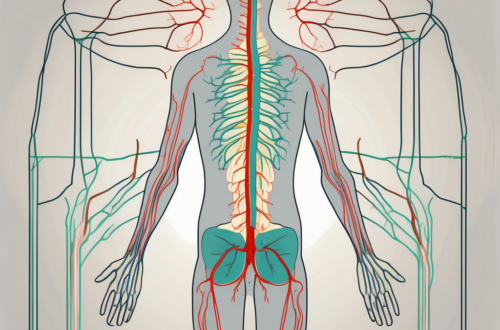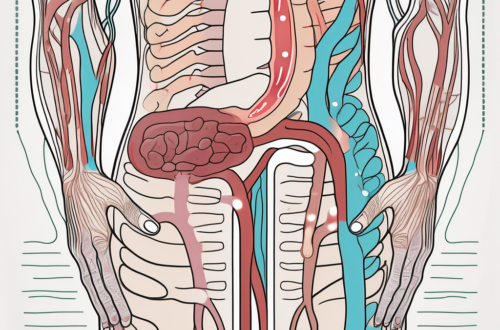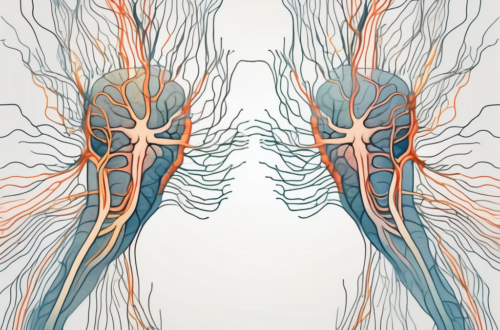The human body is a complex and intricate system, with various networks and pathways working together to maintain optimal health and functionality. One of these essential networks is the autonomic nervous system, which regulates involuntary bodily functions. The autonomic nervous system consists of two branches: the sympathetic nervous system and the parasympathetic nervous system. In this article, we will delve into the fascinating world of the parasympathetic nervous system and explore its role in innervating different areas of the heart.
Understanding the Parasympathetic Nervous System
Before we dive into the specifics of parasympathetic innervation of the heart, let’s first establish a solid understanding of the parasympathetic nervous system as a whole. The parasympathetic nervous system is responsible for conserving energy and promoting relaxation. It counteracts the effects of the sympathetic nervous system, which is responsible for the “fight-or-flight” response.
The parasympathetic nervous system, often referred to as the “rest and digest” system, plays a crucial role in maintaining homeostasis in the body. It controls several vital functions, including digestion, respiration, and heart rate regulation. By stimulating the parasympathetic nervous system, the body can slow down its heart rate, reduce blood pressure, and conserve energy.
One of the key players in the parasympathetic nervous system is the vagus nerve. This cranial nerve extends from the brainstem to various organs in the body, including the heart. It carries parasympathetic fibers that release the neurotransmitter acetylcholine, which binds to receptors on the heart cells and triggers a cascade of events that ultimately slow down the heart rate.
Role of the Parasympathetic Nervous System in the Body
The parasympathetic nervous system’s role extends beyond heart rate regulation. It also plays a vital role in digestion. When we eat, the parasympathetic nervous system is responsible for stimulating the production of digestive enzymes, increasing blood flow to the digestive organs, and promoting peristalsis, the wave-like contractions that move food through the digestive tract.
Furthermore, the parasympathetic nervous system is involved in respiration. It helps regulate the diameter of the airways, ensuring proper airflow to the lungs. By activating the parasympathetic nervous system, the body can promote relaxation of the airway smooth muscles, allowing for easier breathing.
Another important function of the parasympathetic nervous system is its involvement in sexual arousal. When activated, it promotes the release of nitric oxide, a vasodilator that increases blood flow to the genital area, facilitating sexual response.
The Parasympathetic Nervous System and the Heart
When it comes to the heart, the parasympathetic nervous system exerts its influence through specifically targeted nerve fibers. These fibers are responsible for innervating various areas of the heart and modulating its function.
One of the main effects of parasympathetic stimulation on the heart is the reduction of heart rate. This is achieved through the release of acetylcholine, which binds to receptors on the heart’s pacemaker cells, slowing down their electrical activity and subsequently decreasing the heart rate.
Additionally, the parasympathetic nervous system also affects the force of contraction of the heart muscle. It achieves this by inhibiting the release of norepinephrine, a neurotransmitter that increases the contractility of the heart. By reducing the contractility, the parasympathetic nervous system helps conserve energy and prevent excessive strain on the heart.
It is worth noting that the parasympathetic innervation of the heart is not uniform throughout its various regions. Different areas receive different levels of parasympathetic input, allowing for precise control of heart function depending on the body’s needs.
In conclusion, the parasympathetic nervous system is a vital component of the autonomic nervous system, responsible for conserving energy and promoting relaxation. It plays a crucial role in maintaining homeostasis in the body, regulating functions such as digestion, respiration, and heart rate. Understanding the intricacies of the parasympathetic nervous system’s influence on the heart helps us appreciate the complex mechanisms that ensure our cardiovascular health.
Anatomy of the Heart’s Innervation
Now that we have a general understanding of the parasympathetic nervous system, let’s explore the intricate anatomy of the heart’s innervation. The heart is innervated by a complex network of nerves that influence its electrical activity and contraction.
The heart’s innervation is a fascinating topic that sheds light on the intricate mechanisms that regulate its function. Understanding the anatomy of this innervation is crucial in comprehending the complex interplay between the nervous system and the heart.
Overview of Heart Innervation
Heart innervation can be broadly divided into sympathetic and parasympathetic components. While the sympathetic nervous system primarily accelerates heart rate and increases cardiac output, the parasympathetic nervous system functions to counterbalance these effects and restore equilibrium.
The sympathetic innervation of the heart originates from the thoracic spinal cord, specifically the intermediolateral cell column. These preganglionic fibers synapse with postganglionic neurons in the sympathetic chain ganglia, which are located bilaterally along the vertebral column. From there, postganglionic fibers travel to the heart, forming a dense network that innervates various regions, including the myocardium, coronary arteries, and conduction system.
On the other hand, the parasympathetic innervation of the heart arises from the vagus nerves, specifically the right and left vagus nerves. These nerves supply fibers to various regions of the heart, including the sinoatrial (SA) node and the atrioventricular (AV) node.
The parasympathetic fibers that reach the heart originate in the medulla oblongata, specifically the dorsal motor nucleus of the vagus nerve. From there, they travel through the vagus nerves and form synapses with postganglionic neurons located in ganglia near the heart. These postganglionic fibers then innervate the SA and AV nodes, exerting their influence on heart rate and conduction.
It is important to note that the parasympathetic innervation of the heart has a predominantly inhibitory effect. Stimulation of the vagus nerves leads to a decrease in heart rate and a decrease in the force of contraction, ultimately promoting a state of relaxation and conservation of energy.
The intricate balance between sympathetic and parasympathetic innervation ensures that the heart functions optimally under various physiological conditions. This delicate interplay allows for precise regulation of heart rate, contractility, and conduction, enabling the heart to adapt to the body’s demands.
Specific Areas of the Heart Innervated by Parasympathetic Fibers
Now let’s delve deeper into the specific areas of the heart that are innervated by parasympathetic fibers and explore the fascinating implications of their innervation.
The heart, a remarkable organ, relies on a complex network of nerves to maintain its rhythm and function. The parasympathetic division of the autonomic nervous system plays a crucial role in regulating heart rate and ensuring efficient coordination of electrical signals.
The Sinoatrial Node and Parasympathetic Innervation
The sinoatrial (SA) node, often referred to as the “natural pacemaker,” is a small cluster of specialized cells located in the upper part of the right atrium. It is responsible for initiating electrical impulses that propagate throughout the heart, dictating the pace at which it beats.
The parasympathetic fibers that innervate the SA node are derived from the vagus nerve. These fibers release a neurotransmitter called acetylcholine, which binds to specific receptors on the SA node cells. This binding triggers a series of molecular events that ultimately slow down the firing rate of the node, thus reducing the heart rate.
By modulating the activity of the SA node, parasympathetic innervation allows the heart to adapt to the body’s needs. During periods of rest or relaxation, such as when we sleep, parasympathetic activity predominates, leading to a slower heart rate. This helps conserve energy and promotes a state of calmness.
The Atrioventricular Node and Parasympathetic Innervation
The atrioventricular (AV) node, situated between the atria and ventricles, acts as a gatekeeper for electrical impulses traveling from the upper chambers to the lower chambers of the heart. It ensures a brief delay, allowing the atria to contract and fill the ventricles with blood before the ventricles contract.
Parasympathetic fibers innervating the AV node play a vital role in regulating the conduction velocity of electrical signals. When activated, these fibers release acetylcholine, which binds to receptors on the AV node cells, causing a decrease in conduction velocity. This allows for a controlled and synchronized contraction of the heart, optimizing its pumping efficiency.
Interestingly, the parasympathetic innervation of the AV node is not uniform throughout its structure. The fibers are distributed unevenly, with a higher concentration near the top of the node. This arrangement ensures that the electrical impulses are delayed for a sufficient duration, allowing for optimal filling of the ventricles.
Furthermore, the parasympathetic regulation of the AV node is essential in preventing arrhythmias. By exerting control over the conduction velocity, the parasympathetic fibers help maintain the heart’s rhythm and prevent chaotic electrical activity that could lead to irregular heartbeats.
In summary, the parasympathetic innervation of the heart, particularly the SA and AV nodes, plays a crucial role in regulating heart rate, ensuring coordinated contractions, and maintaining a steady rhythm. This intricate interplay between the parasympathetic nervous system and the heart highlights the remarkable complexity and precision of our cardiovascular system.
The Impact of Parasympathetic Innervation on Heart Function
Understanding how parasympathetic innervation influences heart function is essential in comprehending the intricate interplay between the nervous system and cardiovascular health.
The heart, a vital organ responsible for pumping blood throughout the body, is regulated by both the sympathetic and parasympathetic divisions of the autonomic nervous system. While the sympathetic system is known for its role in the “fight or flight” response, the parasympathetic system plays a crucial role in maintaining homeostasis and promoting relaxation.
Parasympathetic Control of Heart Rate
Heart rate control is a classic example of the parasympathetic nervous system’s influence on heart function. Activation of parasympathetic fibers slows down the heart rate, promoting a state of relaxation and lowering the energy demands of the body.
The parasympathetic fibers responsible for heart rate regulation originate from the vagus nerve, also known as the tenth cranial nerve. These fibers release the neurotransmitter acetylcholine, which binds to specific receptors on the heart’s pacemaker cells, known as sinoatrial (SA) node. By binding to these receptors, acetylcholine increases the permeability of potassium ions, leading to hyperpolarization of the SA node cells. This hyperpolarization slows down the rate at which the SA node generates electrical impulses, ultimately resulting in a decreased heart rate.
Furthermore, parasympathetic innervation also influences the atrioventricular (AV) node, which is responsible for transmitting electrical signals from the atria to the ventricles. The release of acetylcholine by parasympathetic fibers decreases the conduction velocity through the AV node, further contributing to the overall slowing of the heart rate.
Parasympathetic Influence on Cardiac Output
While the sympathetic nervous system primarily regulates cardiac output, the parasympathetic nervous system counterbalances these effects. By reducing heart rate and myocardial contractility, parasympathetic innervation helps regulate cardiac output, ensuring it matches the body’s metabolic needs.
Myocardial contractility refers to the force with which the heart muscle contracts during each heartbeat. Parasympathetic fibers release acetylcholine, which binds to receptors on the heart’s myocardial cells, causing a decrease in contractility. This decrease in contractility reduces the force with which the heart pumps blood, contributing to a lower cardiac output.
It is important to note that the parasympathetic influence on cardiac output is not solely limited to the heart rate and contractility. Parasympathetic innervation also affects the blood vessels, specifically the coronary arteries that supply oxygen and nutrients to the heart muscle. Activation of parasympathetic fibers leads to vasodilation of the coronary arteries, increasing blood flow to the heart and improving myocardial perfusion.
In conclusion, parasympathetic innervation plays a vital role in regulating heart function. By slowing down the heart rate and reducing myocardial contractility, the parasympathetic nervous system promotes relaxation and helps maintain a balance between the sympathetic and parasympathetic influences on cardiac output. Understanding the intricate mechanisms by which the parasympathetic system influences heart function is crucial in comprehending the overall cardiovascular health and its implications for various physiological processes.
Disorders Related to Parasympathetic Innervation of the Heart
Although the parasympathetic innervation of the heart plays a crucial role in maintaining cardiac function, disruptions within this intricate network can give rise to various disorders.
Parasympathetic innervation of the heart is responsible for regulating heart rate and maintaining cardiac function. This intricate network of nerves ensures that the heart beats at a steady pace and responds appropriately to changes in the body’s needs. However, when this delicate balance is disturbed, it can lead to a variety of disorders that affect the heart.
Dysautonomia and the Heart
Dysautonomia refers to a condition characterized by dysfunction of the autonomic nervous system. In some cases, dysautonomia can affect the parasympathetic innervation of the heart, leading to disturbances in heart rate control and cardiac function.
When the parasympathetic innervation of the heart is disrupted, it can result in an irregular heart rate, also known as arrhythmia. Arrhythmias can manifest as a fast heart rate (tachycardia), a slow heart rate (bradycardia), or an irregular heartbeat. These abnormalities can cause symptoms such as palpitations, dizziness, and shortness of breath.
If you experience unusual symptoms concerning heart rate or function, it is essential to consult with a healthcare professional for proper evaluation and management. They can perform tests, such as an electrocardiogram (ECG), to assess the electrical activity of your heart and determine the underlying cause of your symptoms.
Heart Disease and Parasympathetic Innervation
Heart disease encompasses a broad range of conditions that affect the structure and function of the heart. While parasympathetic innervation itself is not a direct cause of heart disease, dysfunction within this network can contribute to the development or exacerbation of certain cardiac conditions.
For example, in conditions such as coronary artery disease, where the blood vessels that supply the heart with oxygen-rich blood become narrowed or blocked, the parasympathetic innervation may be affected. This can further compromise the blood flow to the heart, leading to chest pain (angina) or even a heart attack.
In other instances, disorders such as congestive heart failure can disrupt the parasympathetic innervation of the heart. Congestive heart failure occurs when the heart is unable to pump blood effectively, leading to a buildup of fluid in the lungs and other parts of the body. This can result in symptoms such as shortness of breath, fatigue, and swelling in the legs.
A comprehensive evaluation by a healthcare provider is crucial for accurate diagnosis and appropriate treatment. They will assess your medical history, perform a physical examination, and order additional tests, such as echocardiography or stress testing, to determine the extent of the parasympathetic dysfunction and develop a tailored treatment plan.
Future Research Directions in Parasympathetic Cardiac Innervation
The field of parasympathetic cardiac innervation continues to evolve, with ongoing research shedding light on potential therapeutic targets and unanswered questions.
Potential Therapeutic Targets
Understanding the specific mechanisms involved in parasympathetic cardiac innervation opens up new avenues for potential therapeutic interventions. Targeted modulation of parasympathetic activity could provide novel treatment options for various cardiovascular conditions.
Unanswered Questions in Parasympathetic Cardiac Innervation
Despite significant advancements in our understanding of parasympathetic innervation of the heart, certain questions remain unanswered. Further research is needed to explore the intricacies of this network, such as the precise regulation of parasympathetic activity and its interactions with other physiological systems.
In conclusion, the parasympathetic nervous system plays a vital role in innervating different areas of the heart and modulating its function. Understanding the complex interplay between the parasympathetic innervation and cardiac physiology provides valuable insights into the maintenance of cardiovascular health. If you have any concerns or questions about the parasympathetic innervation of your heart, it is always recommended to consult with a medical professional who can provide expert guidance based on your specific circumstances.





